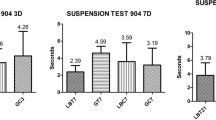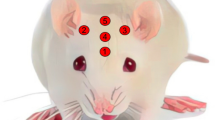Abstract
The purpose of this study is to determine the effects that debris generated by laser and/or balloon on the brain. Debris generated by laser, balloon, and laser combined with balloon were collected and then injected into rats’ left common carotid artery. Rats were divided into five groups: sham, saline, laser (L), balloon (B), and laser combined with balloon (LB). The cognition ability of rats was evaluated by Morris water maze. Cerebral blood flow (CBF) was examined by laser speckle. TTC staining and MRI scan were conducted to detect cerebral ischemic infarction. Intracranial arteries in rats were visualized by MRI angiography via contrast medium injected via tail vein. Immunohistologic staining for NeuN and Iba1 and hematoxylin–eosin staining were performed to assess brain infarction. White matter demyelination was assessed by Luxol fast blue staining. Long-term memory and CBF of rats in different groups exhibited no significant difference. No obstruction sign in intracranial artery tree was noticed in each group. Debris generated by different treatments all caused brain infarction. Infarction lesion caused by debris produced by balloon was much more severe than the one caused by debris generated by laser. While the LB group lay in between. The thickness of white matter decreased in the B group, but not in the L and LB groups. Rat brain has a tolerance for debris as cognition ability and cerebral blood flow are not significantly declined. The severity of cerebral infarction varies by debris generated by different treatments.



Similar content being viewed by others
Data availability
The data that support the findings of this study are available on request from the corresponding author. The data are not publicly available due to ethical restrictions.
References
Luitse MJ, Velthuis BK, Dauwan M, Dankbaar JW, Biessels GJ, Kappelle LJ (2015) Residual high-grade stenosis after recanalization of extracranial carotid occlusion in acute ischemic stroke. Stroke 46(1):12–15. https://doi.org/10.1161/strokeaha.114.007169
Štěchovský C, Hájek P, Horváth M, Špaček M, Veselka J (2016) Near-infrared spectroscopy combined with intravascular ultrasound in carotid arteries. Int J Cardiovasc Imaging 32(1):181–188. https://doi.org/10.1007/s10554-015-0687-x
Iannaccone F, Debusschere N, De Bock S et al (2014) The influence of vascular anatomy on carotid artery stenting: a parametric study for damage assessment. J Biomech 47(4):890–898. https://doi.org/10.1016/j.jbiomech.2014.01.008
Tao Y, Hua Y, Jia L, Jiao L, Liu B (2020) Risk factors for residual stenosis after carotid artery stenting. Front Neurol 11:606924. https://doi.org/10.3389/fneur.2020.606924
Grafmuller LE, Lehane DJ, Dohring CL et al (2023) Impact of calcified plaque volume on technical and 3-year outcomes after transcarotid artery revascularization. J Vasc Surg 78(1):150–157. https://doi.org/10.1016/j.jvs.2023.03.017
Jia L, Hua Y, Jiao L et al (2023) Effects of plaque characteristics and artery hemodynamics on the residual stenosis after carotid artery stenting. J Vasc Surg 78(2):430-437.e4. https://doi.org/10.1016/j.jvs.2023.03.500
Kamenskiy AV, Pipinos II, Dzenis YA et al (2013) Effects of carotid artery stenting on arterial geometry. J Am Coll Surg 217(2):251–262. https://doi.org/10.1016/j.jamcollsurg.2013.03.016
Giannopoulos S, Speziale F, Vadalà G et al (2021) Intravascular lithotripsy for treatment of calcified lesions during carotid artery stenting. J Endovasc Ther 28(1):93–99. https://doi.org/10.1177/1526602820954244
Harada K, Kajihara M, Sankoda Y, Taniguchi S (2019) Efficacy of post-dilatation during carotid artery stenting for unstable plaque using closed-cell design stent evaluated by optical coherence tomography. J Neuroradiol 46(6):384–389. https://doi.org/10.1016/j.neurad.2019.03.006
Teng L, Zhang Y, Fang J, Qu C, Li J, Shen C (2023) Impact of residual stenosis on clinical outcomes when performing carotid artery stenting without postdilation. J Vasc Surg 77(1):182–190. https://doi.org/10.1016/j.jvs.2022.07.021
Ziapour B, Schermerhorn ML, Iafrati MD, Suarez LB, TourSavadkohi S, Salehi P (2020) A systematic review and meta-analysis of predilation and postdilation in transfemoral carotid artery stenting. J Vasc Surg 72(1):346-355.e1. https://doi.org/10.1016/j.jvs.2019.11.044
Yang K, Tan J, Deng Y, Shi W, Yu B (2021) Endovascular debulking of human carotid plaques by using an excimer laser combined with balloon angioplasty: an ex vivo study. Front Cardiovasc Med 8:700497. https://doi.org/10.3389/fcvm.2021.700497
Zhang C, Feng W, Zhao Y et al (2018) A large, switchable optical clearing skull window for cerebrovascular imaging. Theranostics 8(10):2696–2708. https://doi.org/10.7150/thno.23686
Rapp JH, Pan XM, Sharp FR et al (2000) Atheroemboli to the brain: size threshold for causing acute neuronal cell death. J Vasc Surg 32(1):68–76. https://doi.org/10.1067/mva.2000.107315
Zhu L, Hoffmann A, Wintermark M, Pan X, Tu R, Rapp JH (2012) Do microemboli reach the brain penetrating arteries? J Surg Res 176(2):679–683. https://doi.org/10.1016/j.jss.2011.09.059
Rapp JH, Pan XM, Yu B et al (2003) Cerebral ischemia and infarction from atheroemboli <100 microm in Size. Stroke 34(8):1976–1980. https://doi.org/10.1161/01.Str.0000083400.80296.38
Wang Y, Liu G, Hong D, Chen F, Ji X, Cao G (2016) White matter injury in ischemic stroke. Prog Neurobiol 141:45–60. https://doi.org/10.1016/j.pneurobio.2016.04.005
Li S, Rao JH, Lan XY et al (2021) White matter demyelination predates axonal injury after ischemic stroke in cynomolgus monkeys. Exp Neurol 340:113655. https://doi.org/10.1016/j.expneurol.2021.113655
Rapp JH, Pan XM, Neumann M, Hong M, Hollenbeck K, Liu J (2008) Microemboli composed of cholesterol crystals disrupt the blood-brain barrier and reduce cognition. Stroke 39(8):2354–2361. https://doi.org/10.1161/strokeaha.107.496737
Rapp JH, Hollenbeck K, Pan XM (2008) An experimental model of lacunar infarction: embolization of microthrombi. J Vasc Surg 48(1):196–200. https://doi.org/10.1016/j.jvs.2008.01.038
Lam CK, Yoo T, Hiner B, Liu Z, Grutzendler J (2010) Embolus extravasation is an alternative mechanism for cerebral microvascular recanalization. Nature 465(7297):478–482. https://doi.org/10.1038/nature09001
van der Wijk AE, Lachkar N, de Vos J et al (2019) Extravasation of microspheres in a rat model of silent brain infarcts. Stroke 50(6):1590–1594. https://doi.org/10.1161/strokeaha.119.024975
Oraevsky AA, Jacques SL, Pettit GH, Tittel FK, Henry PD (1993) XeCl laser ablation of atherosclerotic aorta: luminescence spectroscopy of ablation products. Lasers Surg Med 13(2):168–178. https://doi.org/10.1002/lsm.1900130204
Malas MB, Dakour-Aridi H, Kashyap VS et al (2022) Transcarotid revascularization with dynamic flow reversal versus carotid endarterectomy in the vascular quality initiative surveillance project. Ann Surg 276(2):398–403. https://doi.org/10.1097/sla.0000000000004496
Schermerhorn ML, Liang P, Eldrup-Jorgensen J et al (2019) Association of transcarotid artery revascularization vs transfemoral carotid artery stenting with stroke or death among patients with carotid artery stenosis. JAMA 322(23):2313–2322. https://doi.org/10.1001/jama.2019.18441
Naazie IN, Magee GA, Mathlouthi A, Elsayed N, Dakour-Aridi H, Malas MB (2021) Primary mechanism of stroke reduction in transcarotid artery revascularization is dynamic flow reversal. J Vasc Surg 74(1):187–194. https://doi.org/10.1016/j.jvs.2020.10.082
Liang P, Soden P, Wyers MC et al (2020) The role of transfemoral carotid artery stenting with proximal balloon occlusion embolic protection in the contemporary endovascular management of carotid artery stenosis. J Vasc Surg 72(5):1701–1710. https://doi.org/10.1016/j.jvs.2020.02.036
Funding
This work was funded by Talents Training Program of Pudong Hospital affiliated to Fudan University (Project no. LJ202202), Pudong New Area Clinical Plateau Discipline Project (Project no. PWYgy2021-03), Pudong Health System Discipline Building Grant Program (Project no. PWZy2020-13).
Author information
Authors and Affiliations
Contributions
Conceptualization: Bo Yu, Weihao Shi, **gdong Tang; methodology: Kai Yang, **yun Tan, Ying Deng, Shuai Jiang; formal analysis and investigation: Kai Yang, **yun Tan; writing—original draft preparation: Kai Yang; writing—review and editing: **yun Tan, Ying Deng, Shuai Jiang, **gdong Tang, Weihao Shi, Bo Yu; funding acquisition: **gdong Tang, Bo Yu; resources: **yun Tan, Weihao Shi, Bo Yu; supervision: Bo Yu. Kai Yang and **yun Tan contributed equally to the present study and should be consider as co-first authors.
Corresponding author
Ethics declarations
Ethics approval
This study was were approved by the Laboratory Animal Welfare & Ethics Committee of Pudong Medical Center, Fudan University, Shanghai, China (No:2021080801).
Competing interests
The authors declare no competing interests.
Additional information
Publisher's note
Springer Nature remains neutral with regard to jurisdictional claims in published maps and institutional affiliations.
Rights and permissions
Springer Nature or its licensor (e.g. a society or other partner) holds exclusive rights to this article under a publishing agreement with the author(s) or other rightsholder(s); author self-archiving of the accepted manuscript version of this article is solely governed by the terms of such publishing agreement and applicable law.
About this article
Cite this article
Yang, K., Tan, J., Deng, Y. et al. Debris generated by laser and/or balloon cause cerebral infarction with different severity. Lasers Med Sci 39, 15 (2024). https://doi.org/10.1007/s10103-023-03904-0
Received:
Accepted:
Published:
DOI: https://doi.org/10.1007/s10103-023-03904-0




